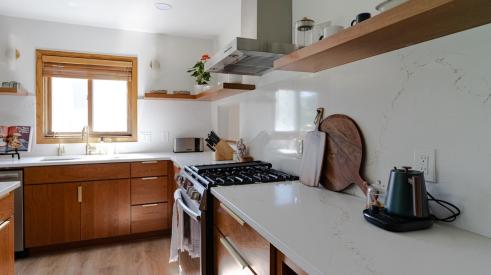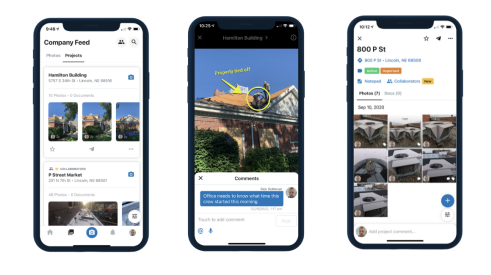|
Like a shy child, this 1926 bungalow peeked out from behind a fence and overgrown landscaping. Even the front door was hidden from view, located at a perpendicular angle to the street. A low roof and shaded front porch further obscured the front elevation.
 |
| Barrel roof tiles for the addition were custom made to match the original roof tiles. The 2 1/2-inch thick circle-top entry door, custom made in Mexico, replicates the arch of the grand window as well as existing arches inside the home. After photos by Paul Body Photography |
The objective was to create a more inviting entry to the home, making it more appealing and visible.
"An entry should say hello and invite a guest to the front door," says Stephen Lusk, CGR, owner of Lusk Building and Remodeling, a design/build remodeler and custom home builder.
Reclaiming the little-used front porch and creating a new entry "opened up the house and made it more social," says Lusk, not only enhancing curb appeal but also interior livability. His firm accomplished this by demolishing the front porch and adding a 20- by 12-foot two-story addition.
 |
| Before |
Constructed with balloon framing, the two-story ceiling extends over a new foyer as well as a new casual eating area. The foyer soars 16 feet, topped by twelve 24- by 18-inch clerestory windows that greatly increase natural light to the interior. Lusk also enlarged openings into the living and dining rooms to open the house visually and increase circulation and natural light.
The remodel changed the indoor traffic flow of the now 2,300-square-foot home. The new floor plan allows entrants easy access to the living room, the formal dining room, the galley kitchen and the informal dining and entertaining area, which overlooks a pastoral garden on the side of the house.
 |
| An interior wrought-iron gate distinguishes the 7 1/2- by 8 1/2-foot eating nook from the foyer. Matching the tile and wood finish floor levels proved challenging, says Stephen Lusk. |
Outside, Lusk sought to enhance the charm of the structure, not create a new home. Building materials and architectural details replicated original elements of the bungalow, located in one of San Diego's oldest subdivisions. Sticking to the Early California architectural style made this project work, says Lusk.
"Good remodeling is copycat design," says Lusk. "It should look like you were never there."
In fact, workers completely demolished the old porch, then formed new footings and poured them into place. Going to two stories for the foyer was necessary in order to converge rooflines, says Lusk, as the home incorporated gable and flat roof areas with barrel tile and parapet trim. The original ceiling plate was established at 96 inches.
Part of the roof was removed and the house was exposed for about 30 days — no problem in dry San Diego. New custom tiles match the 79-year-old tiles on the existing roof. A new, 60- by 54-inch, three-section window on the front of the new addition replicates the look of the previous window.
 |
 |
| Before | After |
Appraisals before and after the three-and-a-half-month remodel showed that the $100,000 investment resulted in an increased value of $300,000, a combination of increased curb appeal and acceleration of the market at the time, says Lusk.
"It doesn't look like an add-on," Lusk points out. "See what is there and repeat it. It is that simple. Be creative with the spaces, not to make the house look differently. Get behind the eyeballs of the original designers."
|
A small addition remakes a front elevation and interior floor plan
Add new comment
Related Stories
Brian Gottlieb Receives Remodeling Mastery Award
Presented by industry icon, Mark Richardson, the award celebrated Gottlieb’s extraordinary impact on remodeling
What's Beyond the Hammer?
Working with Brian Gottlieb on the book Beyond the Hammer provided a masterclass on how to build an aligned team
Real AI Applications For Remodelers
Tech-forward remodeler Michael Anschel shares how he uses artificial intelligence in his business.
How to Eliminate Boring, Languishing Meetings
Leff Design Build ensures maximum productivity and efficiency through these straightforward methods
5 Counterintuitive Strategies to Improve Your Business
Follow these strategies to inspire employees, instill trust, and beat the competition
Couple Act As Much More Than General Contractors
How LBR Partners uplifts and educates their Spanish-speaking trade partners
How to Train for and Run Effective Design-Build Meetings
On this episode of Women at WIRC, Morgan Thomas of LEFF Design Build shares how to maximize your time by creating a culture around effective, collaborative meetings
Pro's Picks: A Real-Time Project Communication and Management Tool
This remodeler says this product allows for easy, quick, real-time communication with team members in the field and in the office
How to Create a World-Class Remodeling Team
Great remodeling companies position themselves for the future with the right players
Everyone Should Have a Number: KPIs for Your Design Build Team
Measuring key performance indicators guides your team to success while creating accountability and ownership












